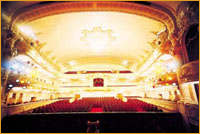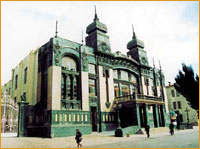|
>
Article published in August 2004
When being a part of the Imperial Iran, Azerbaijan was the province in which the art of dance and music was best preserved and developed. In 1828 Fath-Ali Shah Qajar surrenderd after a war between Iran and Russia and today’s Republic of Azerbaijan was departured from the Iranian province of Azerbaijan. New settlers brought new social and cultural habits to the area which during two centuries made a rich fusion of the essential elements of both cultures. The result of this merge of cultures becomes a fabulous rainbow, a new enriched cultural identity that is characterized by this rich fusion of elements. The particular art form of the region that reflects this mix of culture, is the Azeri architecture which flourished with the influence of both Iranian/Islamic and European/Slav styles. The story of Azerbaijan’s opera and ballet starts in 1910 when the city’s remarkable opera house was built. The legend says that; hearing about the rich music and cultural life of Baku, an Italian Opera singer visited the city in 1909. She was shocked to learn that the city did not have any opera house. And so the diva refused to sing at all, anywhere. An oil baron named Mailov fell in love with her and promised to build her an opera house if she would only return to Baku the following year. Another oil baron, Haji Zeynalabdin Taghiyev, who was experienced in organizing major construction projects, scoffed at Mailov's naivete to think an opera house could be built in such a short time. He challenged Mailov, betting that the building could not be completed within the year. Convinced to see the project as an impossible task he promised to underwrite the costs for its construction if the deadline was met.
The Azerbaijan State Theatre of Opera and Ballet, containing architectural elements of Baroque, Rococo and Moorish style like other national monuments from the beginning of the century, is one of the most ornate music halls in Baku. It remained open until 1983, when it was closed for renovation. By 1985 the building was ready for use again, but burned down under mysterious circumstances. The building was restored once again and reopened on January 3, 1988. The development of national opera is inseparably linked with the founder of Azerbaijan professional music, Uzeir Gadjibekov whose first opera “Leyli and Majnoon” was premiered on January 25, 1908 marking the beginning of Azerbaijan opera. The success of the opera was not unexpected – the genre which was new to both Azerbaijan and the whole Eastern art of music was nevertheless based on well established national traditions in music. Later artists contributed to make a strong links between Azeri opera and folklore music by producing many other works. In 1940 the first ballet by A. Badalbeyli “The Maiden tower” was staged. The performance was based on the key and rhythmical peculiarities of Azeri national dance, music and classical ballet. The production remarked the start of the history of Azeri ballet. During the decades to come the ballet company of the opera produced many ballets based on the country’s history and culture. Some of the most successful Azeri dancers and choreographers who performed on the national scene and also made an international carrier are Gamar Almaszadeh, Leyla Vekilova, Konstantin Batashev, Rafiga Akhundova, Maksud Mamedov, Vladimir Pletnev and Chimnaz Babayeva. During three successful decades besides staging the most popular works of the classical Western dance repertoire the company produced some ballets strongly characterized of Azeri literary heritage. After the fall of Soviet Union when Azerbaijan became an independent state in 1991, all the performing arts were soon feeling financially strapped because the government could no longer carry the weight of expenses as it had during the Soviet period. So in 1997, several international companies established the Opera House Trust Fund initiated by the UNESCO in order to support the Opera and Ballet Theatre. The Fund has already realized some renovation in the theatre. It also has sponsored preparations for performances of "Sevil" by Fikrat Amirov and "Maiden's Tower" by Afrasiyab Babalbeyli. Funds also have been allocated to create new set designs, costumes and even to buy new strings for some of the instruments in the orchestra. Yet the company is facing difficulties as a result of the lack of a solid finance and governmental support. Like other former Soviet republics, many artists of the opera and ballet company have left the country in search of better economic conditions and higher artistic quality. Unfortunately the opera house is suffering from a destructive hierarchy. During recent years two Azerbaijan ballets were revived after many years of oblivion by Les Ballets Persans Company (New Iranian National Ballet) and staged in Stockholm. The premiere of Babek in 2002 remarked the first appearance of Azerbaijan ballet of its kind with strong national features in the West. The Ballet Company of the Baku Opera House has also recently been performing abroad in festivals such as Aspendos International Opera & Ballet Festival in Turkey.
Bibliography Website of
Azerbaijan’s Ministry of Culture
home | introduction | articles
Copyright © 2004
All Rights Reserved.
|
|



